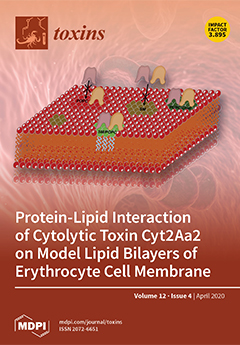Black point is a fungal disease of wheat, mainly associated with mycotoxigenic
Alternaria species. Affected wheat kernels are characterized by dark brown discolouration of the embryo region and reduction of grain quality. Potential risk is the possible accumulation of
Alternaria mycotoxins, alternariol (AOH),
[...] Read more.
Black point is a fungal disease of wheat, mainly associated with mycotoxigenic
Alternaria species. Affected wheat kernels are characterized by dark brown discolouration of the embryo region and reduction of grain quality. Potential risk is the possible accumulation of
Alternaria mycotoxins, alternariol (AOH), alternariol-monomethyl ether (AME), tenuazonic acid (TA), and altenuene (ALT), provided by haemato-toxic, genotoxic, and mutagenic activities. One hundred and twenty durum wheat samples belonging to 30 different genotypes grown in Bologna and Modena areas, in Italy, showing black point symptoms, were analyzed for
Alternaria species and their mycotoxin contamination. Alternariol was selected as an indicator of the capability of the
Alternaria species to produce mycotoxin in vivo in field conditions. The data showed that
Alternaria species occurred in 118 out of 120 wheat kernels samples, with the incidence of infected kernels ranging between 1% and 26%. Moreover, AOH was detected by using a HPLC with a diode array detector (LC-DAD) in 98 out of 120 samples with values ranging between 24 and 262 µg Kg
−1. Ninety-two
Alternaria representative strains, previously identified morphologically, were identified at species/section level using gene sequencing, and therefore were analyzed for their mycotoxin profiles. Eighty-four strains, phylogenetically grouped in the
Alternaria section, produced AOH, AME, and TA with values up to 8064, 14,341, and 3683 µg g
−1, respectively, analyzed by using a LC-DAD. On the other hand, eight
Alternaria strains, included in
Infectoriae Section, showed a very low or no capability to produce mycotoxins.
Full article






